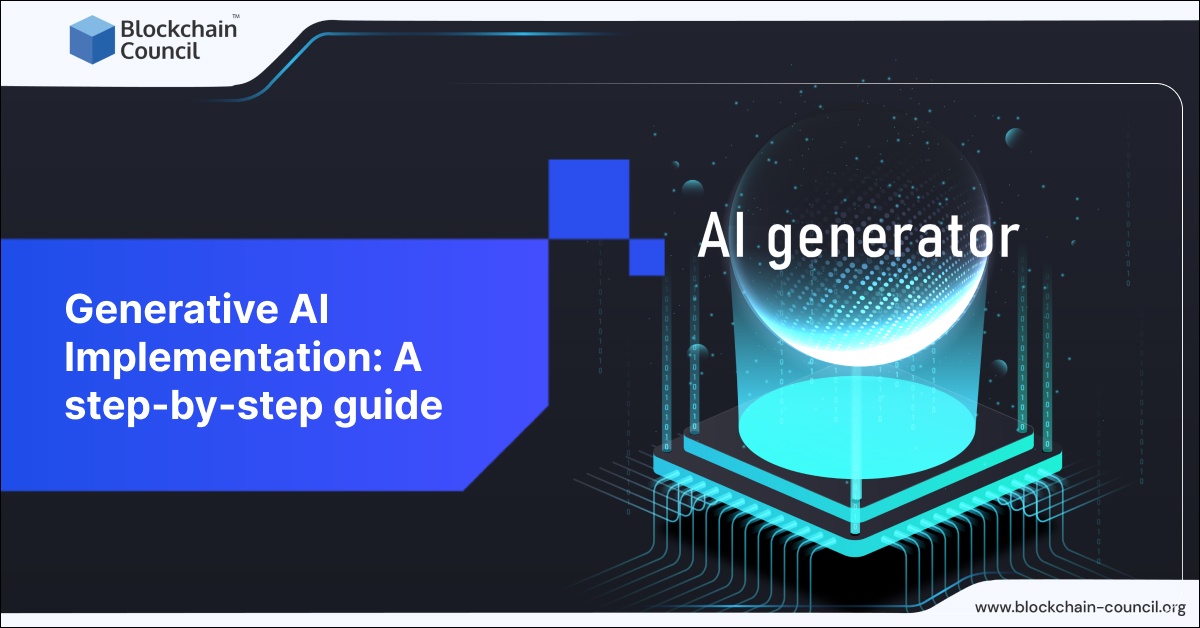Generative Artificial Intelligence (AI) has emerged as a fascinating field within machine learning, enabling systems to produce data that resembles and, in some cases, surpasses human-created content. From generating images and videos to music compositions and text, generative AI opens up a plethora of possibilities across various domains. However, implementing generative AI projects requires a deep understanding of the underlying principles, methodologies, and tools. In this comprehensive guide, we will delve into the practical aspects of implementing generative AI projects, covering key concepts, methodologies, tools, best practices, and real-world applications.
Understanding Generative AI
Generative AI refers to the branch of artificial intelligence that focuses on creating new content or data samples that mimic real-world data distributions. It leverages techniques such as Generative Adversarial Networks (GANs), Variational Autoencoders (VAEs), and autoregressive models to generate content across various domains.
Key Concepts:
Generative Adversarial Networks (GANs):
Introduced by Ian Goodfellow and his colleagues in 2014, GANs consist of two neural networks - the generator and the discriminator, trained adversarially. While the discriminator discerns between genuine and created samples, the generator produces artificial samples. Through iterative training, GANs learn to generate realistic data distributions.
Variational Autoencoders (VAEs):
VAEs, or variational autoencoders, are generative models that pick up hidden meanings from input data. They are made up of a decoder network that reconstructs the input data from the latent space and an encoder network that maps input data to a latent space. By selecting samples from the learned latent space, VAEs are trained to produce new samples.
Autoregressive Models:
Autoregressive models, such as PixelRNN and PixelCNN, generate data sequentially by modeling the conditional probability distribution of each data point given previous data points. These models are commonly used for generating images and text.
Practical Implementation Steps
Step 1: Define the Project Goal:
Before embarking on a generative AI project, it's crucial to define clear objectives and goals. Determine the type of content you want to generate (images, text, music, etc.), the quality of output desired, and any specific constraints or requirements.
Step 2: Data Collection and Preprocessing:
Gather a high-quality dataset relevant to your project domain. Ensure the dataset is diverse, representative, and properly labeled (if applicable). Preprocess the data to remove noise, normalize features, and prepare it for training. Data augmentation techniques can also be applied to increase the variability of the dataset.
Step 3: Choose the Right Model Architecture:
Select an appropriate generative model architecture based on the nature of the data and the project requirements. GANs, VAEs, and autoregressive models each have strengths and weaknesses depending on the application. Consider factors such as training stability, sample quality, and computational resources.
Step 4: Training the Generative Model:
Train the chosen generative model using the preprocessed dataset. Pay attention to hyperparameters such as learning rate, batch size, and network architecture configurations. Monitor training progress using evaluation metrics and visualization tools. Experiment with different training strategies, such as progressive growing (for GANs) or annealing schedules (for VAEs), to improve performance.
Step 5: Evaluation and Fine-tuning:
Evaluate the trained generative model using quantitative metrics (e.g., Inception Score, Frechet Inception Distance) and qualitative assessment by human evaluators. Fine-tune the model based on feedback and iterate on the training process if necessary. Consider techniques such as transfer learning or domain adaptation to improve generalization to new data distributions.
Tools and Frameworks
TensorFlow:
Developed by Google, TensorFlow is an open-source machine learning framework widely used for building and training deep neural networks, including generative models. TensorFlow provides high-level APIs (such as Keras) and low-level operations for flexible model development and efficient computation.
PyTorch:PyTorch, developed by Facebook's AI Research lab, is another popular open-source deep learning framework known for its dynamic computation graph and intuitive API. PyTorch enables researchers and AI developers to prototype and train generative models with ease, offering a rich ecosystem of libraries and pre-trained models.
NVIDIA CUDA Toolkit:
For training deep neural networks, especially large-scale generative models, leveraging GPU acceleration is essential for reducing training time. The NVIDIA CUDA Toolkit provides libraries and tools for parallel computing on NVIDIA GPUs, optimizing performance for deep learning workloads.
OpenAI's GPT (Generative Pre-trained Transformer) Models:
OpenAI's GPT models, including GPT-2 and GPT-3, are state-of-the-art language models capable of generating coherent and contextually relevant text. These models have been pre-trained on vast amounts of text data and can be fine-tuned for specific generative tasks such as text completion, story generation, and dialogue generation.
Best Practices and Considerations
Diversity in Training Data:
Ensure the training dataset is diverse and representative of the target data distribution to avoid bias and improve generalization. Augmenting the dataset with variations of existing samples can also enhance the robustness of the generative model.
Regularization Techniques:
Apply regularization techniques such as dropout, weight decay, and batch normalization to prevent overfitting and improve the generalization performance of the generative model. Experiment with different regularization strengths and strategies to find the optimal balance between model complexity and performance.
Ethical Considerations:
Be mindful of the ethical implications of generating synthetic content, especially in sensitive domains such as deepfakes and misinformation. Implement safeguards and verification mechanisms to prevent misuse of generative AI technology and ensure responsible deployment.
Continuous Monitoring and Maintenance:
Generative models may exhibit unexpected behavior or degrade in performance over time, especially when deployed in real-world scenarios. Establish a system for continuous monitoring and maintenance of deployed models, including regular retraining with updated data and performance evaluation.
Real-World Applications
Art and Creativity:
Digital art and creativity have undergone a revolution thanks to generative AI, which has allowed creators to experiment with new mediums and stretch the bounds of their imagination. . From algorithmic art and procedural generation to interactive installations and generative music, AI-powered tools have become indispensable for creative professionals.
Content Generation and Personalization:
In the entertainment and media industry, generative AI is used for content generation, recommendation systems, and personalized user experiences. Streaming platforms leverage generative models to suggest relevant content based on user preferences and viewing history, enhancing engagement and retention.
Healthcare and Drug Discovery:
In healthcare, generative AI plays a vital role in drug discovery, molecular design, and medical image analysis. Generative models can generate novel chemical compounds with desired properties, accelerating the drug development process and facilitating personalized medicine initiatives.
Natural Language Processing and Dialog Systems:
Generative AI has made significant advancements in natural language processing (NLP) and conversational AI, powering virtual assistants, chatbots, and dialogue systems. Models like OpenAI's GPT have demonstrated human-like capabilities in generating coherent and contextually relevant text, enabling more natural and engaging interactions with AI systems.
Conclusion
Generative AI represents a groundbreaking paradigm shift in artificial intelligence, empowering machines to create content that rivals human creativity and ingenuity. By leveraging advanced machine learning techniques and powerful computational resources, researchers and developers can unlock new possibilities across diverse domains, from art and entertainment to healthcare and education. However, implementing generative AI projects requires careful consideration of data, model architectures, training methodologies, and ethical considerations. With the right approach and tools, generative AI has the potential to revolutionize industries, drive innovation, and enrich human experiences in ways previously unimaginable.


No comments yet